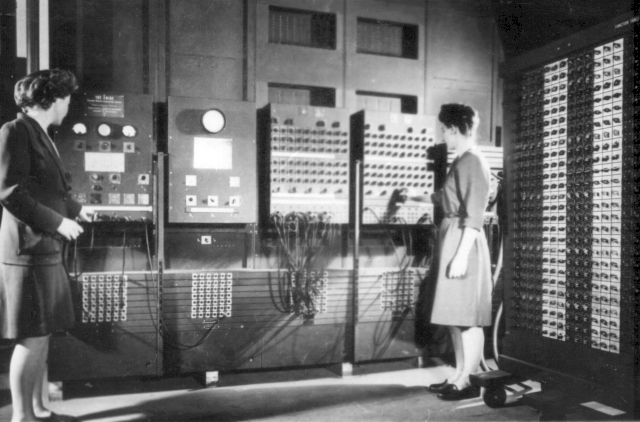|
Sort Merge Generator
The Sort Merge Generator was an application developed by Betty Holberton in 1951 for the Univac I and is one of the first examples of using a computer to create a computer program. The input to the application was a specification of files and the kind of sort and merge operations to use, and the output would be machine code for performing the specification. See also * History of programming languages * History of computers History (derived ) is the systematic study and the documentation of the human activity. The time period of event before the invention of writing systems is considered prehistory. "History" is an umbrella term comprising past events as well ... References # # Notes Text-oriented programming languages {{compu-lang-stub ... [...More Info...] [...Related Items...] OR: [Wikipedia] [Google] [Baidu] |
Betty Holberton
Frances Elizabeth Holberton (March 7, 1917 – December 8, 2001) was an American computer scientist who was one of the six original programmers of the first general-purpose electronic digital computer, ENIAC. The other five ENIAC programmers were Jean Bartik, Ruth Teitelbaum, Kathleen Antonelli, Marlyn Meltzer, and Frances Spence. Holberton invented breakpoints in computer debugging. Early life and education Holberton was born Frances Elizabeth Snyder in Philadelphia, Pennsylvania in 1917. Her father was John Amos Snyder (1884-1963), her mother was Frances J. Morrow (1892-1981) and she was born as the third child in a family of 8 children. Holberton studied journalism, because its curriculum let her travel far afield. Journalism was also one of the few fields open to women as a career in the 1940s. On her first day of classes at the University of Pennsylvania, her math professor asked her if she wouldn't be better off at home raising children. Career During World War 2 while t ... [...More Info...] [...Related Items...] OR: [Wikipedia] [Google] [Baidu] |
UNIVAC I
The UNIVAC I (Universal Automatic Computer I) was the first general-purpose electronic digital computer design for business application produced in the United States. It was designed principally by J. Presper Eckert and John Mauchly, the inventors of the ENIAC. Design work was started by their company, Eckert–Mauchly Computer Corporation (EMCC), and was completed after the company had been acquired by Remington Rand (which later became part of Sperry, now Unisys). In the years before successor models of the UNIVAC I appeared, the machine was simply known as "the UNIVAC".Johnson, L.R., "Coming to grips with Univac," IEEE Annals of the History of Computing , vol. 28, no. 2, pp. 32, 42, April–June 2006. The first Univac was accepted by the United States Census Bureau on March 31, 1951, and was dedicated on June 14 that year. The fifth machine (built for the U.S. Atomic Energy Commission) was used by CBS to predict the result of the 1952 presidential election. With a sample of ... [...More Info...] [...Related Items...] OR: [Wikipedia] [Google] [Baidu] |
History Of Programming Languages
The history of programming languages spans from documentation of early mechanical computers to modern tools for software development. Early programming languages were highly specialized, relying on mathematical notation and similarly obscure syntax. Throughout the 20th century, research in compiler theory led to the creation of high-level programming languages, which use a more accessible syntax to communicate instructions. The first high-level programming language was Plankalkül, created by Konrad Zuse between 1942 and 1945. The first high-level language to have an associated compiler was created by Corrado Böhm in 1951, for his PhD thesis. The first commercially available language was FORTRAN (FORmula TRANslation), developed in 1956 (first manual appeared in 1956, but first developed in 1954) by a team led by John Backus at IBM. Early history During 1842–1849, Ada Lovelace translated the memoir of Italian mathematician Luigi Menabrea about Charles Babbage's newest ... [...More Info...] [...Related Items...] OR: [Wikipedia] [Google] [Baidu] |
History Of Computer Science
The history of computer science began long before the modern discipline of computer science, usually appearing in forms like mathematics or physics. Developments in previous centuries alluded to the discipline that we now know as computer science. This progression, from mechanical inventions and mathematical theories towards modern computer concepts and machines, led to the development of a major academic field, massive technological advancement across the Western world, and the basis of a massive worldwide trade and culture. Prehistory The earliest known tool for use in computation was the abacus, developed in the period between 2700 and 2300 BCE in Sumer. The Sumerians' abacus consisted of a table of successive columns which delimited the successive orders of magnitude of their sexagesimal number system. Its original style of usage was by lines drawn in sand with pebbles. Abaci of a more modern design are still used as calculation tools today, such as the Chinese abacus. In ... [...More Info...] [...Related Items...] OR: [Wikipedia] [Google] [Baidu] |

